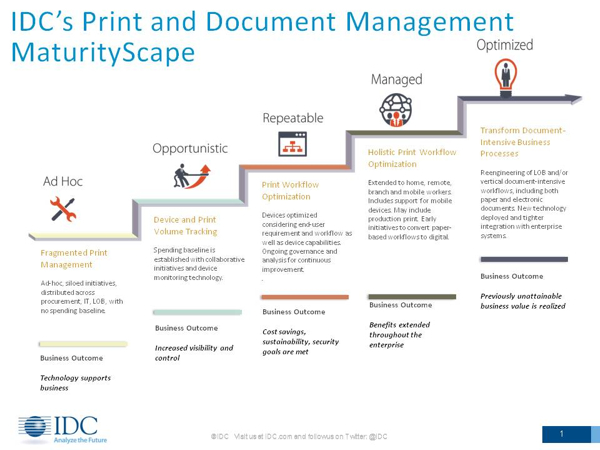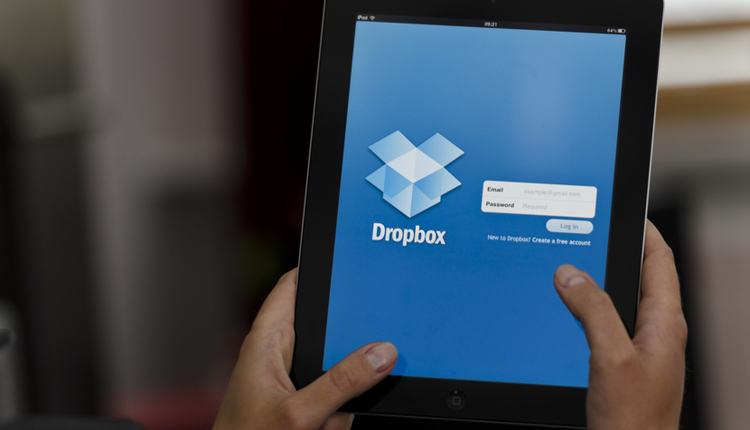
As the economic recovery progresses, organizations continue to seek ways to control costs and boost employee productivity in order to grow or maintain profits. At the same time, the savvy organization is looking for opportunities to boost revenue growth through innovation, best-in-class technologies and process reengineering.
Still, some organizations have little visibility into the total cost of printing and document processes. Print and document management policies, if any exist, are often ad hoc, without collaboration or coordination between disparate functions and business units. Paper and manual processes frequently bridge the gap between incompatible business systems. IDC research has shown that information work is inherently document-intensive and that information workers waste a significant amount of time contending with challenges related to working with documents. In research conducted at the end of 2013, respondents indicated that 55% of all documents that their company used each day were paper-based versus in an electronic format.
MORE: The Paperless Healthcare Office: Will This Change Be a Gradual Incline or a Cliff?
IT managers have the opportunity to mitigate these challenges. An IDC survey of CIOs in the United States and Western Europe ranked increasing productivity high on the list of business initiatives that were expected to drive IT investment, along with reducing costs and improving business processes.
One way to achieve this is to develop or acquire new competencies related to both print and electronic document workflows. Cloud-enabled offerings are contributing to rapid changes in output device architecture and capabilities as well as to print management, content management and mobile print and scan offerings. These technologies facilitate changes that go beyond streamlining existing processes to transforming business models.
IT managers and their colleagues must develop a holistic understanding of their organization's current status in terms of print and document management and a roadmap to effectively leverage new technologies and business models consistent with company strategy and culture. Print and document management refers to policies, processes and technologies that govern document life cycle from creation and capture, through workflow and management, to production and delivery, of both print and electronic documents. A print and document management initiative may be internal or outsourced to a third-party managed print services (MPS) provider. In any case, the organization must have clear objectives and a strategy to attain optimal benefits.
Therefore, a method of assessing print and document management maturity is needed as a planning tool and as a way to determine an organization's progress in adopting print and document management tactics. The IDC Print and Document Management (PDM) MaturityScape describes five stages of maturity.

1. Ad Hoc
Enterprise management of printing resources and document workflows is fragmented across the procurement, IT and line-of-business functions. The enterprise has no formal initiatives to manage printing devices, device deployment or device usage and lacks a consolidated view of print- and document-related costs.
2. Opportunistic
The enterprise has established a specific initiative to track and maintain corporate printing resources, though at the departmental, business unit, site, regional or division level. This provides greater visibility into print volume and costs but does not address end user requirements or device optimization.
3. Repeatable
The enterprise has optimized device types, numbers and locations for best device utilization and cost savings while considering end user proximity, workflow and requirements for print/copy/scan/fax. This initiative occurs at the departmental, business unit, site, regional or division level and requires management support. A governance structure and change management program is implemented to steer the organization toward meeting PDM objectives. Metrics are gathered on an ongoing basis and are used to incrementally improve the capability.
4. Managed
The enterprise deploys print and document management throughout the organization. Device and usage optimization expands beyond the walls of the corporation to include support, tracking and optimization for home, remote, mobile, branch and satellite workers. The organization takes a holistic approach to print and document management. At this stage, the organization is also starting to look at ways to not print at all and to convert paper-based workflows into digital workflows.
5. Optimized
The enterprise has reengineered specific line-of-business and/or vertical document-intensive workflows. This effort may involve the deployment of technologies such as intelligent capture, enterprise content management (ECM), business process management (BPM) and integration with enterprise applications. Service levels are aligned with business goals.
This maturity model enables an organization to assess its print and document management maturity, uncover maturity gaps across business units, use the baseline to define short- and long-term goals and plan for improvements, prioritize managed print and document service engagements and/or print and document management technology, staffing and other related investment decisions and to evaluate managed print and document services providers and offerings.
Holly Muscolino is the research vice president of Document Solutions at IDC. She is responsible for all written research related to document services and the solutions that enable them, including managed print services, related software solutions, the scanning ecosystem and document outsourcing. Follow her on Twitter @hmuscolino.






![IDC graphics for Document Strategy[2]](https://cms-static.wehaacdn.com/documentmedia-com/images/IDC-graphics-for-Document-Strategy-2-.2474.widea.0.jpg)








